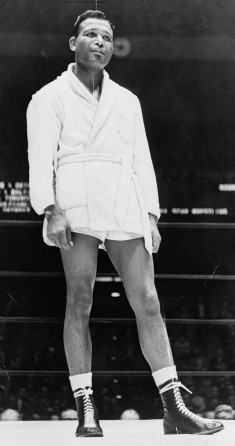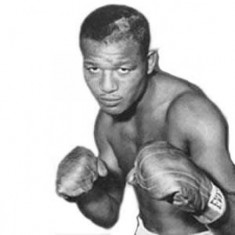| Sugar Ray Robinson | |
|---|---|
 |
|
| Boxer | |
| Born | May 3, 1921 Ailey, Georgia |
| Died | Apr. 12, 1989 (at age 67) Los Angeles, California |
| Nationality | American |
Sugar Ray Robinson was born was born on May 3, 1921, in Detroit, MI. His parents moved to New York when Robinson was only 11 years of age to escape rampant prejudice. But New York proved extremely difficult. With little cash, Robinson helped his family save for a house by earning money tap dancing in Times Square.
Bringing Up a Boxer
The family lived in the area dominated by gangsters. Afraid that her son would join a bad company, Ray’s mother turned to the church, where a man called George Gainford had just set up a boxing club.
It was in Gainford’s gym that Robinson was first introduced to the sport of boxing. Robinson visited the gym regularly, using a boxing card of another boxer. Incidentally, the boxer’s name was Ray Robinson. His unique boxing style in the ring started to draw attention. When coach Gainford watched Robinson fight for the first time, he described him “as sweet as sugar.” Many people agreed and the name stuck.
Early Boxing Career
After winning the New York Golden Gloves in 1940, Sugar Ray became a professional boxer. His very first fight was against Joe Echevarria. He went on to beat him and won five back-to-back fights that year, four of them through knockout. In 1941, in what is described the biggest fight of Robinson’s career, he knocked out Zivic Fritzie in front of a crowd of more than 20,000 spectators. In a re-match in 1942, Robinson knocked out Fritzie Zivic again in the tenth round.
In 1942, Robinson faced Jake LaMotta and defeated him and proceeded to win four more fights. Shortly after, Jake LaMotta came back to avenge his loss. Robinson had been victorious in his first 40 fights and his 41st fight was against Jake LaMotta. The fight ended with LaMotta’s victory. Robinson was knocked out in the eighth round in an earth-shattering fight in Detroit, which drew a record crowd. This was the very first defeat of his boxing career.
Less than a month later, Robinson avenged himself by defeating LaMotta again. Whenever he lost a match (it happened rarely), Robinson would come back in a re-match and pound the other fighter into defeat. Shortly after, he joined the US Army alongside Joe Louis. A year later, Robinson was discharged from the military owing to mental deficiency and returned to boxing. Throughout his career, he was devastating in both the middleweight and welterweight divisions.
Welterweight Championship
 In 1946, he defeated Tommy Bell to earn the welterweight championship in a fight that was described by many as “The War.” Bell was superb in the ring. He knocked down Robinson, but not out. However, Robinson fought back to win the match in a very close decision over 15 rounds to win the welterweight title.
In 1946, he defeated Tommy Bell to earn the welterweight championship in a fight that was described by many as “The War.” Bell was superb in the ring. He knocked down Robinson, but not out. However, Robinson fought back to win the match in a very close decision over 15 rounds to win the welterweight title.
In defending his title the following year, Robinson knocked out Jimmy Doyle in the eighth round. Doyle, who had sustained injuries in the previous matches, never woke up. A few days before that match, Robinson had a dream that he would fortuitously kill his opponent in the ring, and consequently, he wanted to call off the fight. Nonetheless, a minister and a priest convinced him to proceed with the fight. Astonishingly, Robinson knocked out Doyle after eight rounds. Doyle was later pronounced dead.
Boxing Career in Europe
In 1951, Robinson faced Jake LaMotta again. The referee decided to stop the match after 13 rounds when LaMotta could barely stand on his feet. Robinson failed to obey the referee’s directives.
As a result, he was forced to leave the US for a while since Jim Norris, a mob-connected person who ran boxing during those days, froze him out of the US fighting circuit. He went to Europe, where his run of 91 matches without a loss was ended with a match against British boxer Randy Turpin. In the 1960s, Robinson exited the ring gracefully.
Robinson’s Greatest Achievements
Robinson had one of the best boxing techniques ever seen in boxing. He had a quick jab and wonderful knockout power. His record was 128-1-2. Iin 200 matches, he was never physically knocked out (although he received one knockout). In 1997, he was named the best fighter of all time by Ring Magazine.
In 1999, Robinson was named the greatest middleweight and welterweight boxer of the century by the Associated Press. His boxing techniques caused writers and fans to call him “pound for pound,” sentiments that have not faded to date.